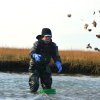Since my article last Friday, I have been contacted by folks from US Wind and Ørsted with information on how the cables will come ashore at Three R’s Road and travel under Indian River Bay to Millsboro, how deep they will be buried and how little they will affect the fish. Unfortunately, all studies to date are in deep water. To the best of their knowledge, no studies have been done on what effects the electromagnetic fields will have on fish in shallow water.
In deep water, as you might expect, there were increased populations of black sea bass and cod around the windmill bases off Block Island. Those bases act as hard structure just like the pilings at the Chesapeake Bay Bridge-Tunnel or the various materials on the bottom at Delaware’s reef sites. All other fish seemed to be little affected by the structure. As mentioned last week, the University of Rhode Island is doing more studies on rays, sharks and lobster, funded by US Wind. There have been some observations of flounder that at first seemed confused around the cables, then moved on over them.
The cables that will travel under Indian River Bay will be buried to a depth of 6 feet. At that depth, according to data from the Bureau of Ocean Energy Management, the electromagnetic field is very weak.
There have also been studies that show electro-magneto-sensitive fish only pick up frequencies between the earth’s magnetic field (0Hz) and EMFs emitted by other marine animals (0-10 Hz). The frequency of the offshore wind cables is 60 Hz, which lab testing has shown to be outside the marine animals’ range of sensitivity.
Make no mistake, the wind farms are a done deal. All we can do is try our best to keep the owners as honest as possible. Make sure they do bury the cables 6 feet deep. Try to get them to give up a few bucks to improve the parking lot at Three R’s Road. Maybe a bathhouse, even? You know, leave it a little better than you found it.
New reef material
On June 29, the 180-foot Texas Star was sunk on the Red Bird Reef, also known as Reef Site 11, by the Delaware Department of Natural Resources and Environmental Control’s Division of Fish and Wildlife.
The Texas Star was built as a floating casino in 1977, then converted into a fishing vessel. It was prepared for sinking by Coleen Marine in Norfolk, Va.
I believe this is the first sinking I have not attended. I received the notice Tuesday morning, and I had already put off my Wednesday deadlines, so I could not go.
I do want everyone to know that this is another example of your fishing license money at work for you.
Fishing report
Fishing is not too bad, not that I can speak from personal experience. I think my rods and reels have cobwebs; it has been that long since I have wet a line.
Delaware Bay has seen some good action with sheepshead. The Outer Wall and the Ice Breakers have given up quite a few, with some approaching 10 pounds. Sand fleas have been the top bait. Tog are also around the same structure, and their season opens today.
The various reef sites have been producing kings, croaker and spot. Bloodworms, Fishbites and small bits of clam will work for bait. There are flounder on the reef sites as well. Try Gulp! on a bucktail. Keep it moving and don’t get caught up in the structure.
The Lewes-Rehoboth Canal gives up some flounder on Gulp! and minnows. Some anglers use both together while others use just Gulp! in white or nuclear chicken.
The fishing pier on Cape Henlopen State Park gives up the occasional keeper flounder on live minnows. The week as saw Ayden Eastep catch a keeper rockfish from the pier. The usual assortment of kings, croaker and spot are also available on bloodworms and Fishbites.
The surf has seen a good run of kings with spot and croaker mixed in the catch. Bloodworms or sand fleas and Fishbites in sand flea or bloodworm have been the best baits.
The Old Grounds have been a bit on and off. Some boats rack up limits of flounder while others don’t do that well. Live minnows, Gulp!, strips of squid and cut bait will all attract flounder. The most recent report I received indicated the ribbonfish have arrived.
Offshore boats have found yellowfin tuna along with golden and blueline tilefish. There are lots of small tuna about, so expect to catch a lot and take home a few.
























































